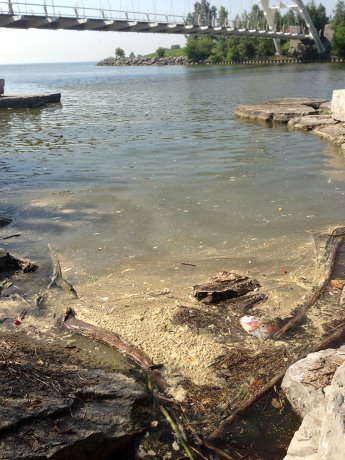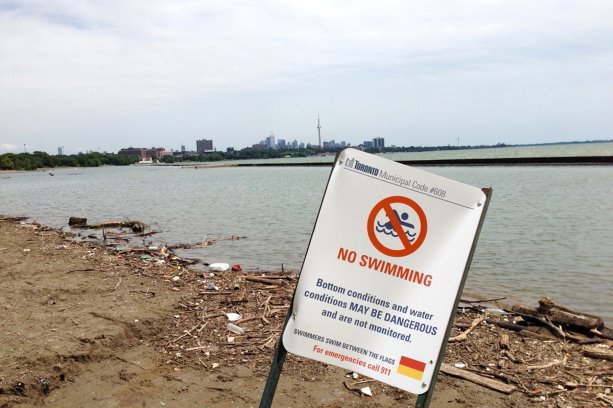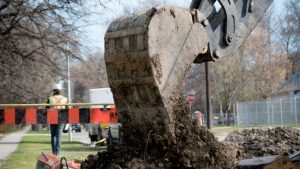Every summer thousands of people paddle, sail and take part in various activities near wastewater treatment plants, not knowing exactly what they are dipping their toes into, or just how many pipes lead into Lake Ontario, states water stakeholder groups.
But a recent Ministry of the Environment and Climate Change (MOECC) decision stating the City of Toronto is to start releasing real time updates to the public about wet weather events and treatment plant bypasses will hopefully raise awareness about aging infrastructure that’s in desperate need of repair, says Krystyn Tully, vice-president of Lake Ontario Waterkeeper.
"The number one reason why we have these water quality issues…is because our infrastructure isn’t up to snuff," she states. "This isn’t a problem that we can get around to fixing it when we can afford to fix it. Every month that goes by that we’re not improving our system, it gets worse."
Giovanni Cautillo, executive director of the Ontario Sewer and Watermain Construction Association, says this is an issue that can’t be ignored across the province.
"What we pull into our taps, that we then distribute to all the municipalities in Ontario, is from Lake Ontario. If you soil that then you’re treating it on the front end as well as on the back end, which to me doesn’t make much sense," he says, adding the MOECC announcement is encouraging but more work has to be done.
"It’s a good first step, but ultimately it’s only a step to fixing a symptom, not the cause. I see the cause as being this antiquated system of combined sewer and storm overflow pipes. As soon as we have a little bit of moisture that accumulates, it automatically bypasses and then you get sewage. Get rid of that old system. Let’s fix the problem at its source."
According to Lake Ontario Waterkeeper, sewage bypasses happen about three times a month, all year round. They filed a legal application under the Ontario Environmental Bill of Rights in July 2014 asking that the City of Toronto be required to alert the public during sewage bypasses and spills so that people can avoid polluted areas. The Waterkeeper was prompted to file the application after a massive storm in 2013 knocked out power at the Humber River treatment plant.
"Wastewater flowed into Lake Ontario for 28 hours and the city failed to alert residents. Government monitoring showed elevated levels of bacteria offshore in Lake Ontario," states a release.
"Giving people the information they need to protect their health is incredibly important," adds Tully.
"We’re hoping that with more information about the impact that our infrastructure is having on water quality, they’ll start connecting those dots and see the value in investing in infrastructure improvements and upgrades."
According to the City of Toronto, many of the older parts of the city’s sewage collection system consists of combined sewers that carry both sanitary and storm water flows. The city’s extensive storm sewer system is 4,500 kilometres in all, with 2,600 outfalls or outlet pipes, it states.
"In some cases, stormwater mixes with wastewater in the combined sewers or infiltrates into sanitary sewers," the city explains. "This causes the wastewater system and the city’s sewage treatment plants to be overloaded and untreated water enters our rivers, streams and Lake Ontario."
A wastewater treatment plant bypass happens when the volume of wastewater reaching a plant exceeds the volumes "that it can reasonably process in a short period of time," says the city. "For sewage systems with combined sanitary, and storm sewers like Toronto, this is always due to a rain event."
The city notes a bypass in this context "means that some flows have bypassed one portion (the biological process) of the wastewater treatment process, not the entire treatment process. The wastewater is still screened and disinfected. Because bypassing of the biological process happens during storm events, the excess water is mostly rain water and is blended with fully treated plant flow prior to being discharged to the environment."
Both Tully and Cautillo state anything that compromises water quality should be made public in real time, but also shouldn’t be happening in the first place.
"There has to be an asset management study done at the city level. Find out what it would take cost wise in order to update this entire system. It’s imperative, not only for us, but our future generations," Cautillo explains. "Where something bypasses a treatment plant and gets dumped into Lake Ontario, is not acceptable. Full stop."
Tully says the MOECC has stated it plans to look into rolling out similar practices across the province.
"By giving people real time notifications when there are these overflow events and these bypasses they can start to connect the infrastructure to their day to day lives in a much more tangible way," she states.
"If you’re sailing a boat in the Toronto harbour and the Humber wastewater treatment plant has been on bypass for 10 hours, you have a right to know that that’s happening."
The City of Toronto said in a statement they intend to work with the MOECC "on continuing to provide accurate, meaningful and reliable public education and awareness on the complex issue of water quality…Toronto Water welcomes the opportunity to consult on these issues and support in the development of any procedures and protocols."
When it comes to infrastructure, Toronto Water’s 10-year capital budget includes spending $1.1 billion on the Wet Weather Flow Master Plan to improve stormwater quality that is released to the city’s waterways and Lake Ontario; $60 million was slated for 2015.
For Cautillo, however, the sooner matters of water quality are addressed along "every municipality attached to the lake" the better.
"The public needs to be educated," he says. "Water is your life blood for any community. Why are we treating it like it’s nothing? You can’t mistreat something and expect it to have longevity."









Recent Comments
comments for this post are closed